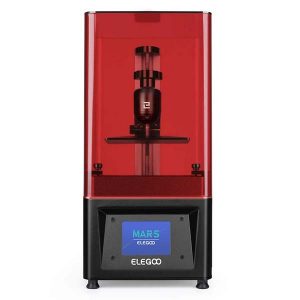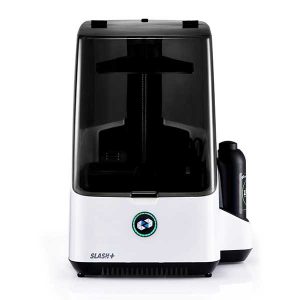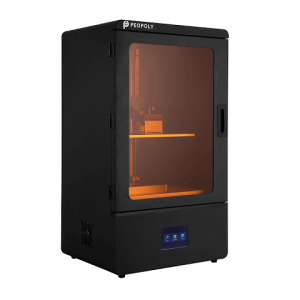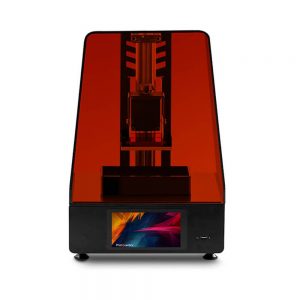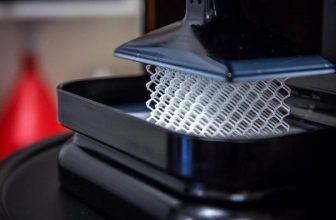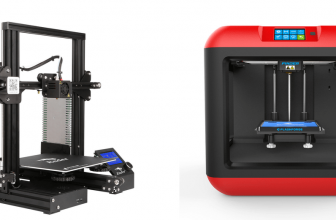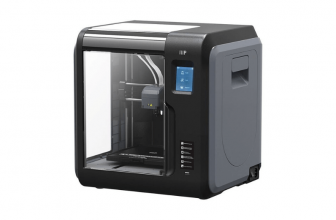Digital Light Processing (DLP), Stereolithography (SLA), and LCD are three resin 3D printing techniques that are quite similar. They all use photopolymer resins cured in a resin tank to create solid 3D printer models.
LCD 3D Printers project a light pattern onto an LCD display module, used to cure the resin in the resin vat. The light source is LED, and the LCD screen controls the light pattern. From the LED lamp, light is emitted. It is then absorbed by the resin after passing through an LCD screen.
On the LCD screen, a picture of each layer is created, and the entire layer is hardened at the same time. LCD 3D printing is a resin manufacturing technology that produces large, detailed functional objects at a low cost.
Thanks to 3D printers with larger build trays produced by Photocentric, for example, this 3D printing technique focuses on mass manufacturing and large component 3D printing for resin materials.
How does It work?
UV LCDs are used as light sources in LCD 3D printers, as previously stated. The light shines in a parallel pattern through the LCD screens onto the build area in LCD 3D printers. Furthermore, no lens or other equipment is used to magnify the light. As a result, when dealing with an LCD 3D printer, pixel distortion is not an issue.
This clearly indicates that the print quality is unaffected by the model’s size change after projection. It is, however, contingent on the LCD density. The smaller the pixels, the better the print quality.
Comparison Chart
| Name | Link | Nomination |
|---|---|---|
| Prusa Research Original Prusa SL1 | High quality printing | |
| ANYCUBIC Photon | Excellent print quality | |
| Elegoo Mars | Fast printing | |
| Creality LD-002H | Affordable | |
| Uniz Slash Plus | Full featured printer | |
| Nexa3D NXD200 | Fastest 3D Printer | |
| T3D High-Speed | Fully assembled | |
| Peopoly Phenom | Easy to use |
|
| Photocentric LC Precision 1.5 | High resolution printing | |
| Nova3D Bene4 Mono | Powerful |
Prusa Research Original Prusa SL1
|
Prusa Research’s Original Prusa SL1 is an open-source desktop LCD 3D printer developed in the Czech Republic by Prusa Research.
The Prusa SL1 LCD 3D printer is simple enough for novices and hobbyists to use, yet precise enough for professionals (jewelry, dentistry, prototyping, etc.).
Uses:
- This resin 3D printer can print layers as thin as 0.01mm thick.
- The maker claims that its Tilting print bed prevents layer shifting and stirs the resin.
- With the help of its resin level sensor, the SL1 can determine whether there is enough resin to complete a 3D print.
- Flexible FEP film is used in the resin tank, and it is inexpensive and simple to replace.
- Users can use any type and brand of resin they like.
- The SL1 also includes auto-calibration, a quick-release construction plate, vapor extraction, and other user-friendly features.
- A full-color LCD touchscreen is also included.
- When used correctly, can produce outstanding print quality with precise detail
- The menu system is simple to use and navigate
- There are multiple ways to connect
- There were many misprints since the first layers didn’t always stick to the build platform
- Cleaning and maintaining resin tanks are difficult tasks
- Build volume is limited
- A little costly
ANYCUBIC Photon
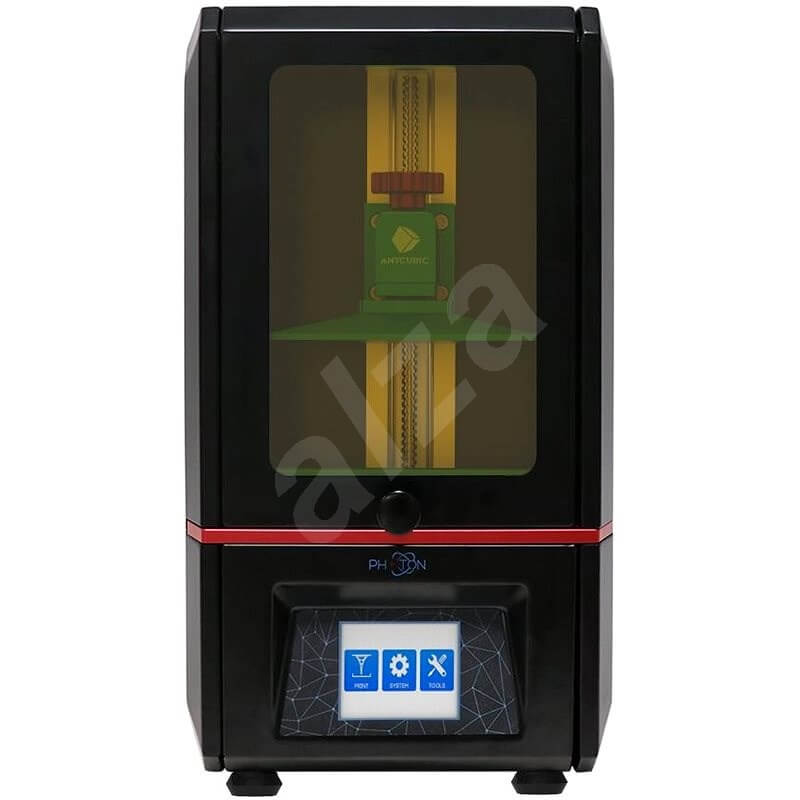
The ANYCUBIC Photon can fit on a desktop without taking up too much room. The design of the casing is excellent. There are no loose joints, no sheet metal wobbles, and strong adjustable feet.
Uses:
- The resin vat and print platform, which are the major functioning pieces, are composed of anodized aluminum.
- On either side of the Photon UV, there are two practical carry handles built into the cabinet.
- During printing, a strong fan at the back of the unit exhausts heat and harmful gases from the cabinet.
- The LCD interface is well designed and simple to use.
- You may save your model to a USB stick for printing and then insert it into the Photon UV’s USB port.
- Its own Photon slicing software is used for printing.
- In comparison to other LCD 3D printers, it is quite inexpensive
- Simple to set up and use
- Produces high-resolution prints with a resolution of 25-100 microns
- Size is small and effective
- Adequate assembling, cleaning, and other instructions
- Custom slicer that generates a nice support structure
- Build volume is limited
- Resin 3D printing can be a pain to work with
- Patience and room are required for post-processing
- Cleaning a printer properly takes time
- Safety equipment is required (but also provided)
- When working with dangerous materials, the user must exercise caution
Elegoo Mars
|
The ELEGOO Mars is the solution to your prayers if you’ve been looking for a low-cost 3D printer that produces high-quality 3D prints. This inexpensive LCD 3D printer generates high-quality prints and does not appear to be cheap.
Uses:
- The ELEGOO Mars has an orange top over an aluminum base.
- The ELEGOO Mars arrives fully assembled. In addition, everything you’ll need to print your first 3D model is included in the box.
- Because of the printer’s tiny size, it doesn’t take up a lot of room, allowing you to be freer when determining where to put it.
- ELEGOO adds a sensitive touch display to the front of the base, allowing you to fine-tune the controls and settings for your prints.
- A USB port is located on the back of the 3d printer, and this is where you insert the flash drive containing the print files.
- This LCD 3D printer’s user interface is simple to operate, thanks to its huge 3.5-inch 2K high-definition touch display with a resolution of 2560 by 1440 pixels.
- A printer with a low-price tag that delivers high-quality prints
- It’s simple to use and only takes a few minutes to put together
- Aluminum and an orange cover combine to create an eye-catching style
- The printing procedure is quite straightforward
- The cost of accessories and supplies can quickly add up
- You can’t stop or turn off the high-pitched beeping sounds
- The volume of the build is smaller than the average
Creality LD-002H
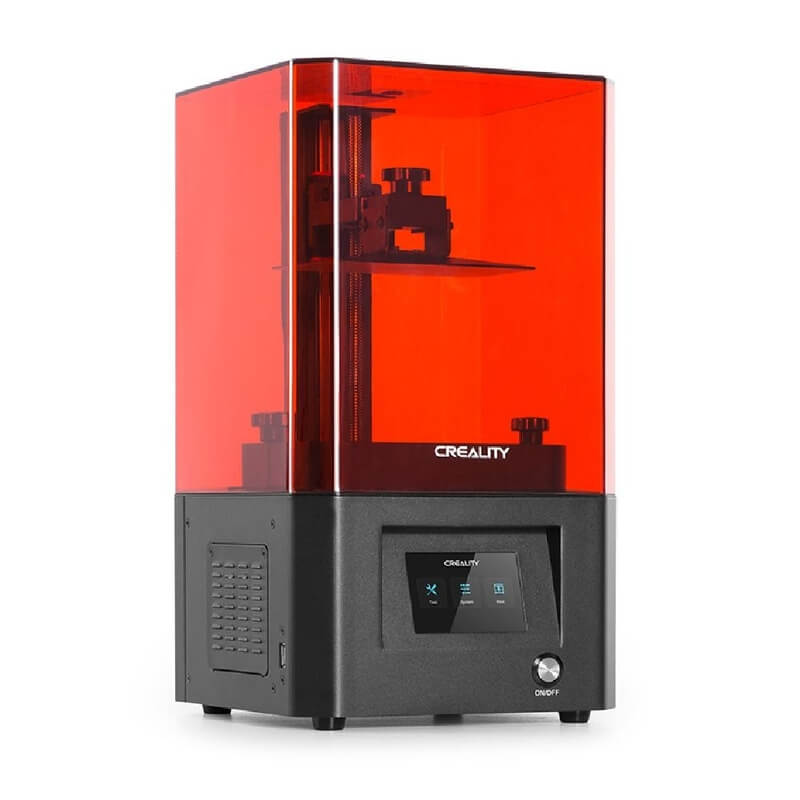
Creality has already snagged a small piece of that landscape with the release of its first resin 3D printer, the well-received but unspectacular LD-002R.
Uses:
- The system includes a 2K monochrome screen with a print volume of 130 x 82 x 160 mm.
- The vat is perhaps the second most significant printer feature, behind the screen and all the magic that happens beneath it.
- The incorporation of protruding bumps at the bottom of the vat makes it a little simpler to place it correctly onto the screen, but it also gives protection to the sensitive FEP foil stretched over the bottom of the vat.
- Air filtering is the next item on the list.
- The printer has a compact footprint and a top cover that can be removed, as is typical of the genre.
- On the front of the LCD 3D printer is a 3.5-inch color touchscreen with ChituBox firmware and a power-off button.
- On prints, the surface finish is excellent
- Filtration of the air
- Pricing on a shoestring
- There is no Wi-Fi available
- VAT is missing some useful features
Uniz Slash Plus
|
The Uniz Slash Plus is a compact and elegantly designed desktop 3D printer and is one of the fastest printers in the market. It is the first printer to be using UDP technology. It enables high-speed printing with exceptional print results.
This LCD 3D printer is unique and allows you to manufacture layer-less objects with extremely high resolution, with a minimum resolution of 10-micron layer thickness.
The Uniz Slash Plus printer can print at a speed of up to 1,000 cm3 per hour. The Uniz Slash Plus printer was created with designers and professionals in mind, so it gives them the best possible outlet to express their creativity.
Uses:
- It has a build volume of 192 × 122 × 200 mm, which allows you to print with ease without limitation of space.
- Because it can be connected to multiple devices through the internet, the printer may be controlled remotely.
- It has the capacity to automatically calibrate.
- It is built on a big granite construction plate.
- During the printing process, the construction plate remains stable for smooth and flawless printing.
- The printer film can last for 1000 printing hours
- It also has an automatic resin-refilling pump.
- Its resin mat can be easily changed
- Allows use of different materials for printing
- User-friendly interface
- Accurate and precise printing results
- It is an expensive printer so it isn’t easily accessible for just anyone
Nexa3D NXD200
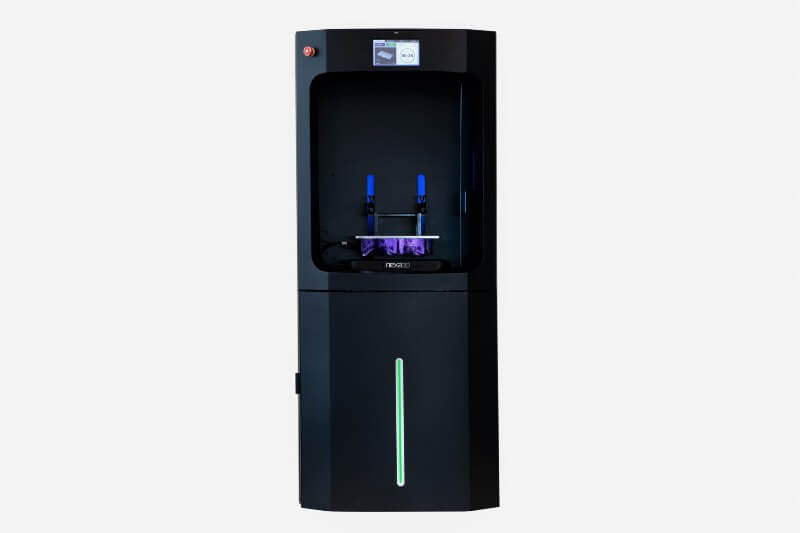
Nexa 3D NXD200 is a sleek designed LCD 3D printer perfect for dental application printing with intelligent optimization and Nexa 3D’s revolutionary patented LSPc technology.
It is a resin-based 3D printer that is operating on Nexa’s proprietary Lubricant Sublayer Photo-curing (LSPc) 3D printing technology.
Uses:
- It has a build volume of 275 x 155 x 200mm, which allows large printing.
- It has continuous 3D printing at speeds of up to 1 Z centimeter per minute to allow quick printing.
- The Nexa 3D NXD200 produces accurate, durable prints for dental applications.
- The Nexa 3D printer features cognitive, advanced smart 3D print software, including real-time monitoring, optimizing, and diagnostics.
- It allows large scale printing
- It has a continuous printing speed of 1 Z centimeter per minute
- It has an elegant ans sleek design which makes it attractive
- It features intelligent optimization
- It is built with an Everlast membrane to extend the life of Nexa3D liquid interface technology
- It produces prints with high accuracy in minimal time
- The Nexa3D offers real-time monitoring features and advanced smart 3D print software
- It has Nexa3D’s revolutionary patented LSPc technology
- It has a 20X productivity in comparison to its competitors
- It is not suitable for printing applications for purposes other than dentistry
- The price is not pocket friendly hence cannot be purchased on a whim
- The Nexa 3D printer is not portable due to its heavyweight and large size
T3D High-Speed
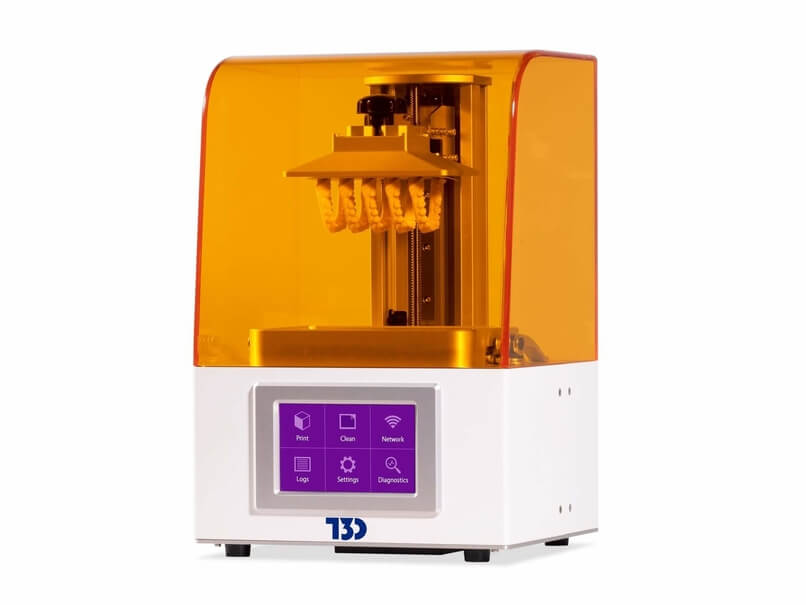
The T3D LCD High-Speed LCD 3D printer is a recently launched 3D printer with a smart and compact look with enclosed space printing for easy portability. It has an easy-to-use interface and T3D claims that its new High-Speed 3D Printer can print at the speeds of up to 10 cm per hour, speeding up the 3D printing process.
According to a press release, the device can print constantly because of the startup’s numerous colors of visible light curing photosensitive resin and “unique fep film”. This printer supports materials such as Thermoplastics > Standard (PLA, ABS, etc) during printing.
Uses:
- It comes with a clout Gallery App which has a variety of public models to get your desired print in just one click.
- It has an enclosed print space which lessens the harmful fumes exposure during printing.
- It has a speed of printing up to 10 centimeters per hour for fast and easy printing.
- The T3D LCD High-Speed 3D printer guarantees high productivity and accuracy.
- The T3D High-Speed 3D Printer has a precision of 47 um and innovative software for a smoother workflow.
- It is a compact design
- Easy portability
- High productivity and accuracy
- High precision of 47 um
- Easy access app for the printing of desired print with just one click
- Enclosed space for less exposure to harmful fumes
- Attractive design
- User-friendly interface
- Noisy printing
- Heavyweight
- Not budget-friendly
- Slower printing speed in comparison to its competitors
Peopoly Phenom
|
The Peopoly Phenom is an extremely classy and elegantly designed LCD 3D printer with a build volume of 276 x 155 x 400 mm and a resolution of 72 um. Because the entire layer of resin is cured, this printer is faster than conventional resin technologies when 3D printing a large object or a full plate of little objects.
Peopoly’s proprietary light engine, which uses MSLA technology and a cooling system to increase print outcomes while extending the mask’s life, offers even more light distribution than other printers.
Phenom makes use of widely adapted Chitubox firmware/software, allowing consumers to upgrade from their existing smaller LCD printers with ease.
Uses:
- It is adaptable to existing smaller screen LCD printers easily.
- Its large build volume of 276 x 155 x 400 mm makes it easy to print large projects.
- It has a simple design with very few moving parts.
- It has enclosed space printing which limits the exposure to harmful fumes.
- It has a touchscreen display which makes it very easy to use.
- Pocket friendly
- Large build area
- Accurate and Precise printing
- Attractive design
- Easy to use
- Enclosed printing caused less exposure to fumes
- The parts wear out sooner so need to be replaced or repaired frequently
- Large prints can take over 24 hours of time to finish
- It has no Wi-Fi on the 3D printer, despite the on-screen display advertising it as a feature
Photocentric LC Precision 1.5
|
The Photocentric LC Precision 1.5 is a compact LCD 3D printer with an attractive design and enclosed print space. The Photocentric LC Precision 1.5 is one of the fastest 3D printers available in the market.
This 3D printer is able to function as a standalone unit with increased precision and accuracy and comes with a build volume of 121 x 168 x 160 mm.
A disposable vat system, a user-friendly touch screen, and other innovative technologies are included in the Photocentric LC Precision 1.5 printer.
Uses:
- It has a build volume of 121 x 168 x 160 mm, which allows for a good printing size
- It includes features like a touch screen that enables the user to design and customize different models accordingly and a disposable vat system that makes it user-friendly with an easy-to-use interface.
- It features a layer thickness of 25 microns and a 47-micron XY precision.
- The printer is also compatible with the company’s vast choice of resins, allowing you to print a wide range of models.
- It also has a resume print function, which enables you to begin printing from where you left off, in case of a power failure to save projects.
- It uses Photocentric own software that helps you, design models, with detail.
- Quick printing with minimal chances of error
- Fully assembled
- Sufficient build volume
- Precise and accurate prints
- Less exposure to harmful fumes during printing
- The print bed needs improvement
- Noisy printing
Nova3D Bene4 Mono
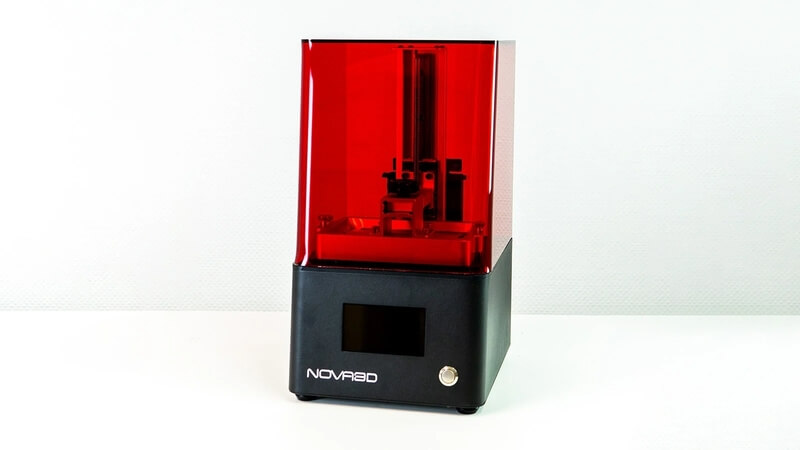
The Nova3D Bene4 Mono is a desktop LCD 3D printer from the Chinese company NOVA3D. It’s a low-cost resin printer with a 2K monochrome LCD screen that delivers excellent print quality.
The printer is as simple to use as resin-based printers can be, and there is some excellent quality of life features included in the design.
Uses:
- The Nova Bene4 Mono has a monochrome 6.08-inch screen.
- With a print surface of 130 mm x 80 mm and a 2K display of 2560 x 1620 pixels beneath, the non-monochrome Bene4 achieves XY precision of 50 microns while maintaining the industry standard layer height of 10 microns.
- For remote control, Bene4 Mono offers wireless connectivity.
- Nova3D’s Bene4 Mono comes with NovaMaker, a proprietary slicing program.
- The Bene4 Mono features the same no-leveling architecture as the company’s earlier resin machines.
- The flip-top lid is really useful.
- Wi-Fi connection with excellent print quality
- There is no air filtration.
Buying Guide
It’s a good idea to know which characteristics are essential before buying an LCD 3D printer. The following are a handful of the most important aspects. These features will make your 3D printing experience more fun and worry-free!
- Fits Your Budget: Anything other than a 3D printer budget should be considered when selecting a 3D printer. Obviously, you do not want to give an arm and a leg to buy a model. No? Keep a close eye on your budget and include things like an LCD 3D printer.
- Speed and Volume: If speed is important to you, opt for a printer that prints with a smooth finish. However, post-processing is required when using LCD 3D printers to produce models. Select a printer with a high build volume if you wish to print numerous pieces at the same time.
- High Resolution: The resolution occurs in 3D printer spec sheets more frequently than any other attribute. The Z resolution is determined by the layer thicknesses that a 3D printer can create. Some of the best Z resolutions are found in LCD resin 3D printers (thinnest layers). A variety of layer height settings are usually available to users. The optimal range for getting high-resolution prints is 25 to 300 microns. This enables designers to create the right combination of speed and precision.
- Precision And Accuracy: A number of things influence precision and accuracy. Materials, software settings, 3D printing method, post-processing, and other aspects are among them.
- Reliability: Every customer expects reliability, whether it’s from an LCD 3D printer or not. What if the 3D printer functions for a few days before ceasing to function as it once did? What if your 3D printer isn’t working properly every now and then? If the outcomes aren’t consistent, it’s also untrustworthy. So, keep an eye out for it and join online communities.
- Online community support: LCD resin 3D printers are among the most precise and accurate 3D printers available. Entry-level LCD printers, on the other hand, may rely on lasers, off-the-shelf projectors, or galvanometers. Their producers will make every effort to get the most out of these components.
Every customer expects reliability, whether it’s from an LCD 3D printer or not. What if the 3D printer functions for a few days before ceasing to function as it once did? What if your 3D printer isn’t working properly every now and then? If the outcomes aren’t consistent, it’s also untrustworthy. So, keep an eye out for it and join online communities.
FAQs
What Is The Best Way To use An LCD 3D Printer?
Objects must be sliced with a slicer, much like in traditional 3D printing (prepped for printing with 3D printing software). Almost any common 3D file type can be used (STL, OBJ, etc).
Simply ensure that the final sliced file type is compatible with your 3D printer. Load your object onto the LCD printer once it’s been sliced (often via USB or microSD card). The object can then be printed by selecting it.
What Is UV Printing, And How Does It Work?
Some 3D printers to cure each layer use UV light. UV printers are another name for these printers. For layer curing, they have a dedicated UV light panel. 2D printers that use UV curing ink are also available.
What Types Of Resin Printers Are Available?
Resin printers come in a variety of shapes and sizes, but two varieties now dominate the market: Digital Light Processing 3d printers and Stereolithography 3d printers. Each one builds objects layer by layer using liquid resin.
What Type Of Resin Is Used By Resin Printers?
Photopolymer resin is used in the majority of 3D printers. There are a number of producers who offer a range of colors, from opaque to translucent. Check with your printer’s manufacturer to see which resin type they recommend for your device.
What Are The Dimensions Of LCD Printers?
The build plate size of most casual LCD printers is roughly 10cm across. Larger build platforms are available with industrial resin printers, allowing for uses that are more practical. These machines have an additional fee.
How Long Does It Take For Resin Prints To Cure?
The slicing program determines the cure time for resin-produced products. By altering the exposure time, you may control how long each layer is cured.
To improve adherence to the build plate, you may want to give the initial layers a longer cure period. A typical exposure cycle for each layer lasts 10 to 15 seconds. The faster your thing prints, the shorter it is.
Is It Possible To Make Money With An LCD 3D Printer?
Resin printers are no exception to the many possibilities to make money with 3D printing. You can print your own stuff to sell, as well as print for others.
Conclusion
LCD resin 3D printers are among the most precise and accurate 3D printers available. Entry-level LCD printers, on the other hand, may rely on lasers, off-the-shelf projectors, or galvanometers. Their producers will make every effort to get the most out of these components.
LCD is particularly significant when compared to other technologies. It doesn’t have anything to sell in the lower price bracket, but it claims to be able to make intricate designs with great precision. As a result, extra caution should be applied while selecting an LCD 3D printer price range that is appropriate.




